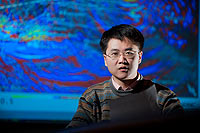ACADEMIA
Po Chen to be first UW professor to use supercomputer
One day, Po Chen may be referenced in the Wyoming Almanac. For now, he’s likely the envy of many of his fellow University of Wyoming researchers.
Chen, a professor of geology and geophysics in UW’s School of Energy Resources, will make history of sorts when he becomes the first UW faculty member to conduct research at the NCAR-Wyoming Supercomputing Center (NWSC). NCAR is now conducting final tests on the $30 million supercomputer, before it is officially launched for use.
“What I’ve heard is we can access it (supercomputer) in two and a half weeks,” says Chen, who will model a detailed, physics-based seismic hazard map of the state of California for the Southern California Earthquake Center (SCEC).
The goal of the research, which Chen says is often referred to as “Cyber Shake,” is to identify areas with high-seismic hazards in the Golden State. Such information can help communities there strengthen their current building codes; assist the insurance industry in setting rates based on an area’s hazard level; and possibly save lives.
While the data are being collected by researchers at SCEC and the University of Southern California, Chen and his team of three doctoral and two masters’ students will create the 3-D computer model to use on the supercomputer in Cheyenne.
Chen described some of the current seismic maps as “empirical,” with many entailing small areas – roughly only a few square kilometers around fault areas. “Many people think areas close to fault traces are the most dangerous. This may not be true,” Chen says. “Reverberations of geological structures beneath the surface can have large effects on where ground shaking will be the strongest. This often occurs in thick sedimentary basins.
“Many people think areas close to fault traces are the most dangerous. This may not be true,” Chen says. “Reverberations of geological structures beneath the surface can have large effects on where ground shaking will be the strongest. This often occurs in thick sedimentary basins.
“For some regions, building codes may not be sufficient. For other regions, communities may not have to update their codes,” Chen says. “This (modeling) will potentially provide more accurate seismic hazard maps for earthquake engineering in California. I think this research will have a long-lasting effect on how buildings are constructed in California and will affect the home insurance industry.”
Select company
As part of an NCAR contest, seven projects nationwide were chosen to use the supercomputer for the Accelerated Scientific Discovery (ASD) initiative, says Bryan Shader, UW’s special assistant to the vice president for research and economic development and a professor of mathematics. ASD is essentially the opportunity -- before the facility is in full use by multiple groups of researchers -- to use the supercomputer and test its full capabilities, much like a photographer testing out a new camera to see what new subtleties in color and crispness can be achieved.
“You essentially give one person or group the opportunity to use the entire new resource at one time,” Shader says.
“A rigorous process was used to select projects that promised the possibility of significant new discoveries from what is one of the world’s premier supercomputers,” says Bill Gern, UW’s vice president for research and economic development. “The unique environment at NWSC -- coupling the use of very large data sets and a peta-scale computer -- will produce important new knowledge about the Earth’s natural systems.”
“This is probably one of the more practical research projects,” Chen says. “It will have some impact on human life.”
Later this fall, Chen and other UW faculty members will simultaneously conduct their own computational science research projects on the supercomputer. The National Science Foundation initially chose seven UW projects that will be led by university faculty and use approximately 27 million core hours on the supercomputer.
The NWSC is the result of a partnership among the National Center for Atmospheric Research (NCAR); the University of Wyoming; the State of Wyoming; Cheyenne LEADS; the Wyoming Business Council; Cheyenne Light, Fuel and Power; and the University Corporation for Atmospheric Research. NCAR is sponsored by NSF.
The NWSC will contain some of the world's most powerful supercomputers (1.5 petaflops, which is equal to 1.5 quadrillion computer operations per second) dedicated to improving scientific understanding of climate change, severe weather, air quality and other vital atmospheric science and geo-science topics. The center also will house premier data storage (11 petabytes) and an archival facility that holds irreplaceable historical climate records and other information.
NCAR officials now are testing the supercomputer and readying it for the NWSC open house, scheduled noon- 4 p.m. Monday, Oct. 15, in Cheyenne’s North Range Business Park. The NWSC also will include an interactive visitors' center, which will be unveiled at the open house.
